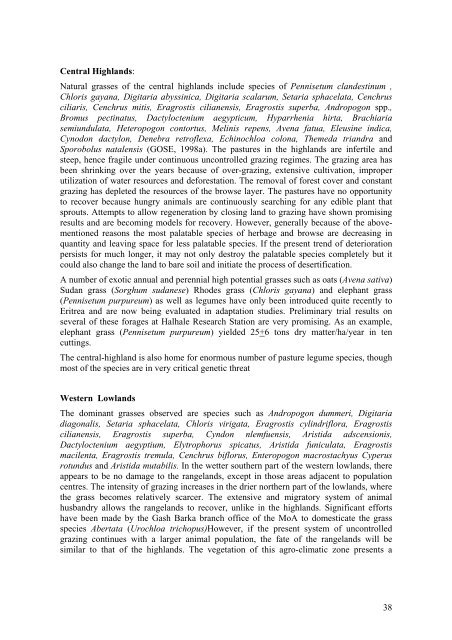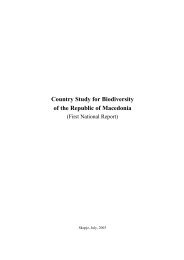English version - Convention on Biological Diversity
English version - Convention on Biological Diversity
English version - Convention on Biological Diversity
You also want an ePaper? Increase the reach of your titles
YUMPU automatically turns print PDFs into web optimized ePapers that Google loves.
Central Highlands:<br />
Natural grasses of the central highlands include species of Pennisetum clandestinum ,<br />
Chloris gayana, Digitaria abyssinica, Digitaria scalarum, Setaria sphacelata, Cenchrus<br />
ciliaris, Cenchrus mitis, Eragrostis cilianensis, Eragrostis superba, Andropog<strong>on</strong> spp.,<br />
Bromus pectinatus, Dactyloctenium aegypticum, Hyparrhenia hirta, Brachiaria<br />
semiundulata, Heteropog<strong>on</strong> c<strong>on</strong>tortus, Melinis repens, Avena fatua, Eleusine indica,<br />
Cynod<strong>on</strong> dactyl<strong>on</strong>, Denebra retroflexa, Echinochloa col<strong>on</strong>a, Themeda triandra and<br />
Sporobolus natalensis (GOSE, 1998a). The pastures in the highlands are infertile and<br />
steep, hence fragile under c<strong>on</strong>tinuous unc<strong>on</strong>trolled grazing regimes. The grazing area has<br />
been shrinking over the years because of over-grazing, extensive cultivati<strong>on</strong>, improper<br />
utilizati<strong>on</strong> of water resources and deforestati<strong>on</strong>. The removal of forest cover and c<strong>on</strong>stant<br />
grazing has depleted the resources of the browse layer. The pastures have no opportunity<br />
to recover because hungry animals are c<strong>on</strong>tinuously searching for any edible plant that<br />
sprouts. Attempts to allow regenerati<strong>on</strong> by closing land to grazing have shown promising<br />
results and are becoming models for recovery. However, generally because of the abovementi<strong>on</strong>ed<br />
reas<strong>on</strong>s the most palatable species of herbage and browse are decreasing in<br />
quantity and leaving space for less palatable species. If the present trend of deteriorati<strong>on</strong><br />
persists for much l<strong>on</strong>ger, it may not <strong>on</strong>ly destroy the palatable species completely but it<br />
could also change the land to bare soil and initiate the process of desertificati<strong>on</strong>.<br />
A number of exotic annual and perennial high potential grasses such as oats (Avena sativa)<br />
Sudan grass (Sorghum sudanese) Rhodes grass (Chloris gayana) and elephant grass<br />
(Pennisetum purpureum) as well as legumes have <strong>on</strong>ly been introduced quite recently to<br />
Eritrea and are now being evaluated in adaptati<strong>on</strong> studies. Preliminary trial results <strong>on</strong><br />
several of these forages at Halhale Research Stati<strong>on</strong> are very promising. As an example,<br />
elephant grass (Pennisetum purpureum) yielded 25+6 t<strong>on</strong>s dry matter/ha/year in ten<br />
cuttings.<br />
The central-highland is also home for enormous number of pasture legume species, though<br />
most of the species are in very critical genetic threat<br />
Western Lowlands<br />
The dominant grasses observed are species such as Andropog<strong>on</strong> dummeri, Digitaria<br />
diag<strong>on</strong>alis, Setaria sphacelata, Chloris virigata, Eragrostis cylindriflora, Eragrostis<br />
cilianensis, Eragrostis superba, Cynd<strong>on</strong> nlemfuensis, Aristida adscensi<strong>on</strong>is,<br />
Dactyloctenium aegyptium, Elytrophorus spicatus, Aristida funiculata, Eragrostis<br />
macilenta, Eragrostis tremula, Cenchrus biflorus, Enteropog<strong>on</strong> macrostachyus Cyperus<br />
rotundus and Aristida mutabilis. In the wetter southern part of the western lowlands, there<br />
appears to be no damage to the rangelands, except in those areas adjacent to populati<strong>on</strong><br />
centres. The intensity of grazing increases in the drier northern part of the lowlands, where<br />
the grass becomes relatively scarcer. The extensive and migratory system of animal<br />
husbandry allows the rangelands to recover, unlike in the highlands. Significant efforts<br />
have been made by the Gash Barka branch office of the MoA to domesticate the grass<br />
species Abertata (Urochloa trichopus)However, if the present system of unc<strong>on</strong>trolled<br />
grazing c<strong>on</strong>tinues with a larger animal populati<strong>on</strong>, the fate of the rangelands will be<br />
similar to that of the highlands. The vegetati<strong>on</strong> of this agro-climatic z<strong>on</strong>e presents a<br />
38
















